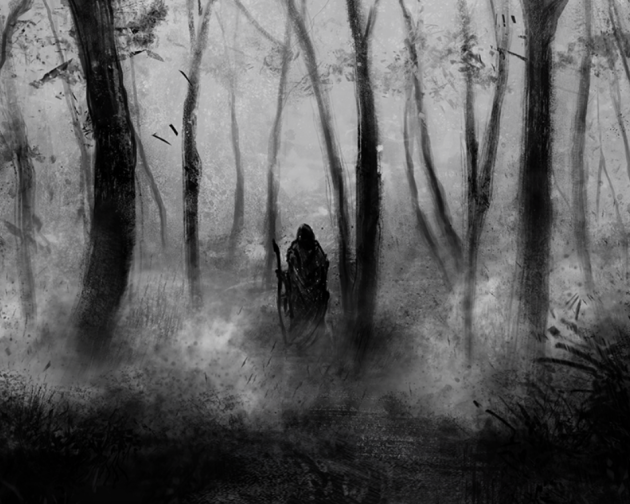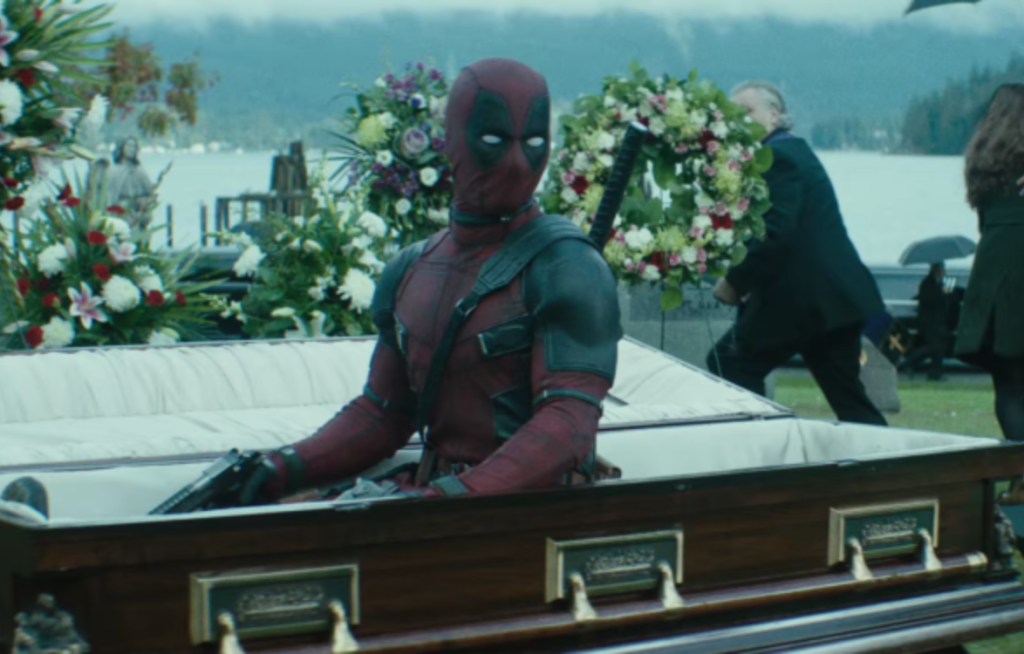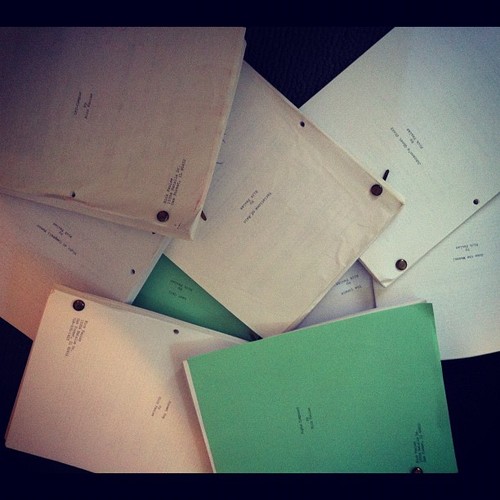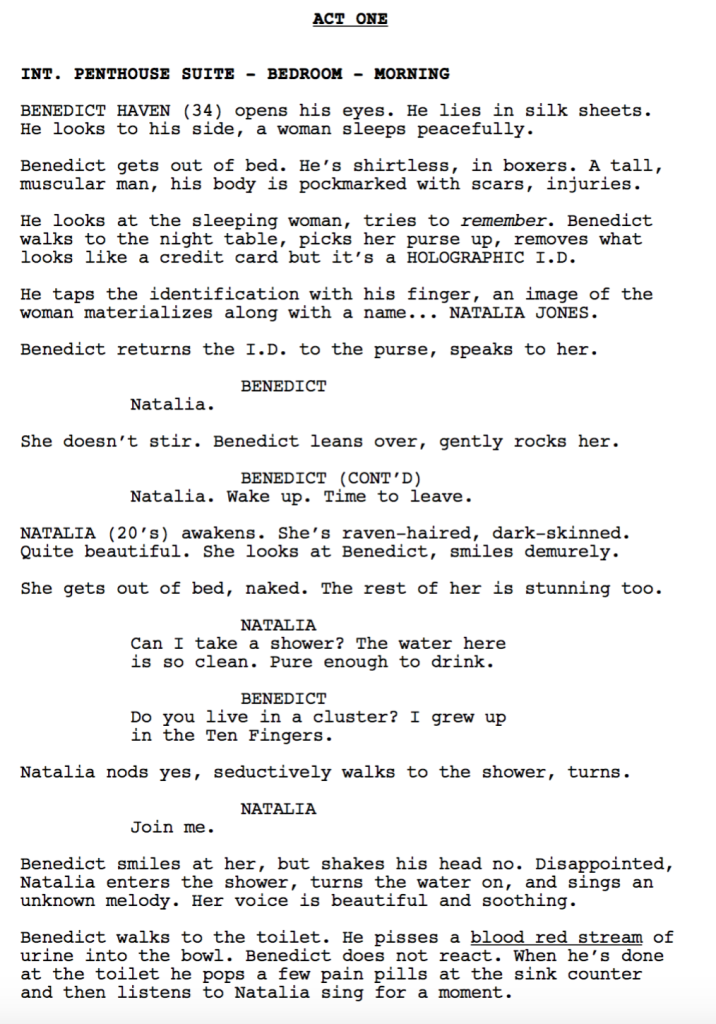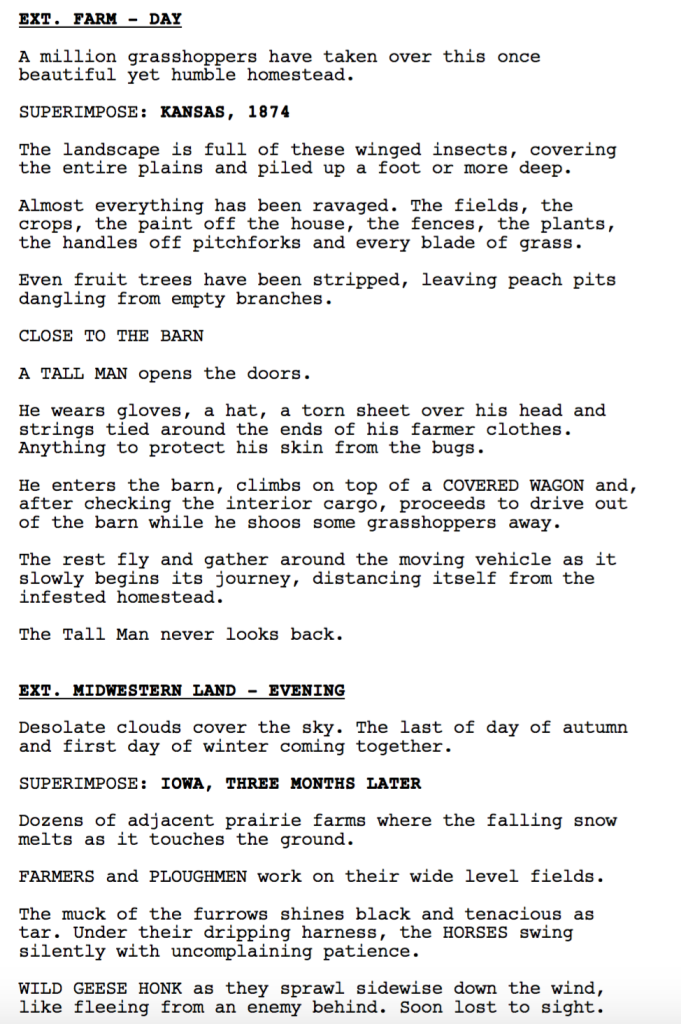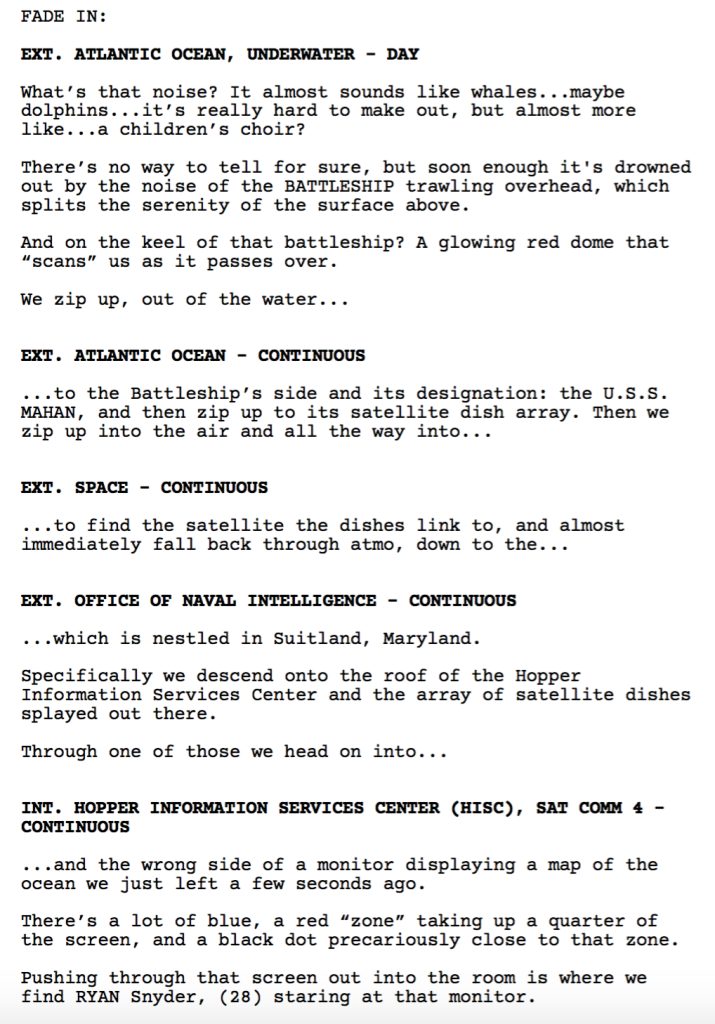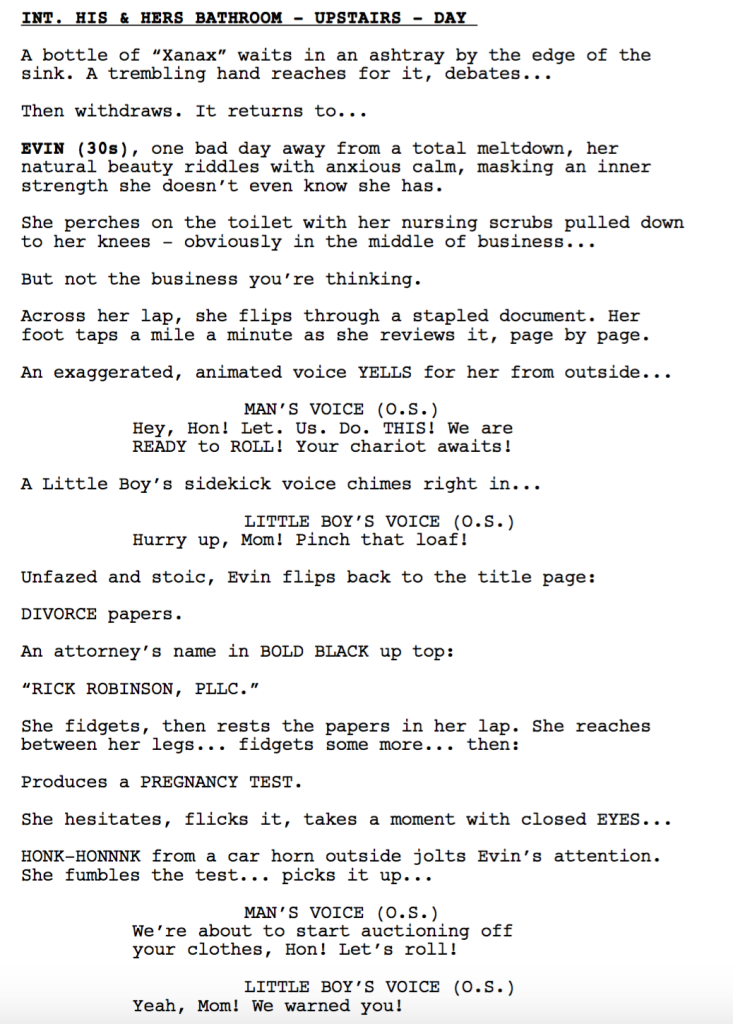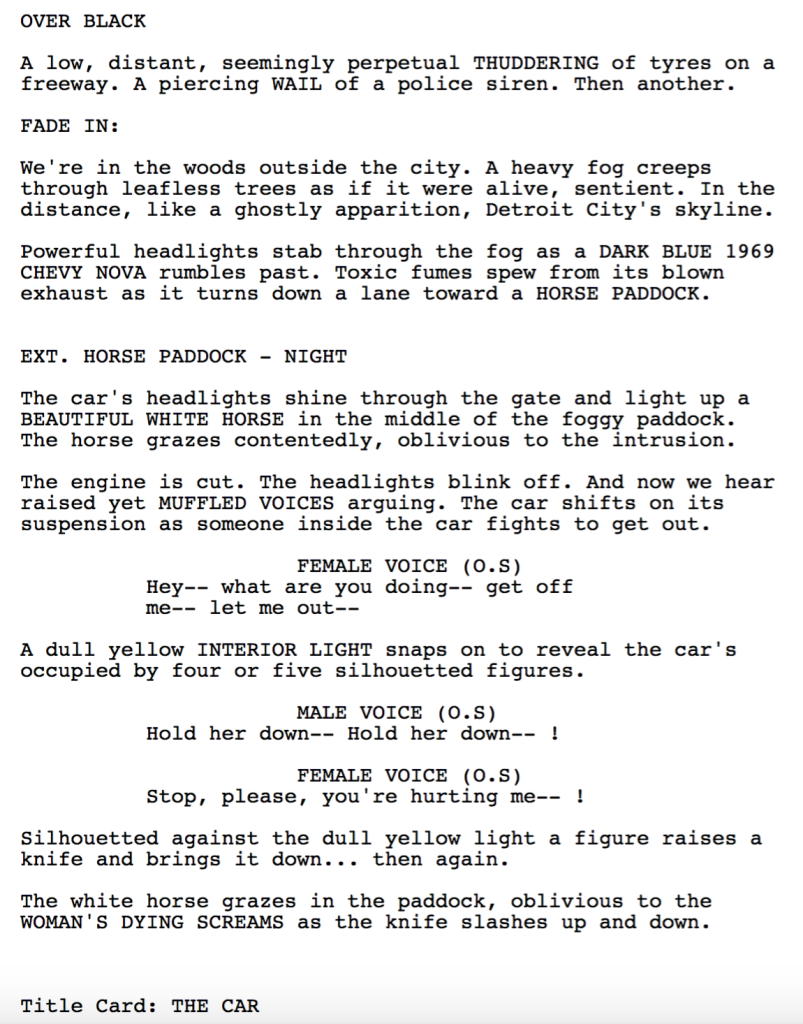Genre: TV Pilot – Drama
Premise: A group of Boston friends’ lives are changed after a member of their group unexpectedly commits suicide.
About: Today’s pilot comes from former comedy writer DJ Nash, who took a chance in writing his first drama. That chance paid off when ABC made it their first pickup of the season, positioning it as a This is Us counterstrike. Nash formally created Growing up Fisher and Truth Be Told. Ron Livingston and Romany Malco star in the show.
Writer: DJ Nash
Details: 57 pages
TV pilots are funny things. The shows with the longest staying power tend to have the weakest concepts. That’s because TV shows are character-driven as opposed to concept or plot-driven. Why is that? Well, if you’re writing 20 hours of television per season, that’s 18 hours more than a feature film. Seeing as it’s hard enough coming up with a series of cool plot points for a feature, you can imagine how hard it must be when you multiply that by ten.
Therefore, TV has no choice but to focus on character.
But this is what’s always confused me about TV. How do you get anybody’s attention with a lame character-driven concept? Like if you pitched me, “Four Boston friends have their lives uprooted when their friend dies,” I’d be like, “Annnnnnnd???” With a movie pitch, you know what you’ve got after the logline. With these things, it seems like a crapshoot.
Anyway, I’ll continue to stir fry that thought in my head while I dish out today’s review.
Rome, an almost-30 commercial director with the perfect life, is two minutes away from ending it. He’s got the pills. He’s prepping the deed. It’s only a matter of time. But before we watch him kill himself, we cut to his friend Jon, who has an even better life. The master of the deal and a real estate titan, Jon is currently on the phone, closing a deal in his kick ass high-rise office. How easy is it to love life when you’re killing it?
Cut to friend numero 3, Gary. Gary is getting the results from his doctor about whether his cancer’s back. His breast cancer. Yes, Gary is in the one percent of males who have breast cancer. But the good news is, he’s making it work for him. Gary bangs a new breast cancer survivor every week at his breast cancer support group.
Finally, there’s Eddie. Eddie hates his wife. Every day she drags him deeper into the pits of married hell. And while Rome’s about to off himself and Gary’s ready to get his results and Jon is ready to close the deal, Eddie is throwing all of his clothes into a suitcase. Eddie’s about to run away with another woman.
But then he gets the call from Gary that changes everything.
Jon just committed suicide.
That’s right. Not Rome. Jon. After he closed that deal, he leapt out the window.
The rest of the script has the guys coming together for Jon’s funeral and the gathering afterwards. The wives are all there, including Maggie, the latest girl Gary banged from his support group. Yes, their first date is officially a funeral.
As the group ponders the impossibility of someone like Jon, who had everything, ending his life, little hints pop up that there may be more to the story. When the guys go get tonight’s Bruins tickets from Jon’s office (going to Bruins games is a long-standing tradition), they get into Jon’s phone and find out that he made one call before he jumped. To Eddie.
The guys turn to Eddie, who looks back cluelessly. He never got a message. But later that night (major spoiler), when Eddie is alone, we see why he’s being so coy about that call. We finally find out who Eddie’s been planning to run away with. It’s none other than Jon’s wife.
I had mixed green feelings about this script.
I loved the early misdirect. Nash totally got me with Jon’s death. And I liked the ending twist, that Eddie was running away with Jon’s wife. Not only for the twist. But because you’re setting up a line of dramatic irony that can be drawn out for 5-6 episodes. Us and Eddie know that Jon may have killed himself because he found out that Eddie was sleeping with his wife. But the other friends don’t know that. And like any good line of dramatic irony, it’s the kind of thing that viewers will stick around for to see what happens when that bomb explodes.
My problem with A Million Little Things was the rest of the script, the middle part.
It’s mainly just a bunch of characters being sad, talking to each other, remembering things. And I think the problem here is that Nash didn’t use a good old fashioned goal. There are some writers who don’t think you should use goals in TV one-hours. That it’s more about “covering the bases” of each subplot. But I find that when there’s an overarching goal pushing the characters along, it gives the narrative an engine. We feel like there’s a PURPOSE to the story.
It’s not to say you HAVE to do this. If we’re inside of a particularly dramatic portion of a season, then each storyline (the A, B, or C) in an episode can be powerful enough that a uniform goal isn’t required. But my theory with pilots is that you can’t take any chances. You can’t even RISK a 3-5 minute down period. Because 3-5 minutes is all it takes these days for someone to decide your show is boring and never watch it again. TV viewers are not a forgiving bunch. I’ve met them.
With that said, there are still plenty of good things to talk about. When you’re writing a character driven pilot (as opposed to concept-driven pilot), you want to get an inciting incident into the story ASAP. Usually within the first 5 pages. This is to alleviate any suspicion that your show will be a group of characters talking for an hour. You need that “thing” to happen so that they know you mean business. A character dramatically killing themselves, via a misdirect, was a great way to get audiences hooked.
Building off of yesterday’s character development talk, we see again today how important it is to establish characters immediately. The first scene we meet each character in A Million Little Things is a scene where we learn the essence of who they are at this moment in their lives. Gary has breast cancer. Eddie is about to leave his marriage. Rome is suicidal. One of the biggest mistakes I see amateur writers make is they take 3, 4, 5 or MORE scenes to tell us what professional writers can tell us in one.
That’s not to say you can’t have characters of mystery, like John Locke in Lost. That’s a different discussion. But when dealing with straight-forward characters, you want to start developing them from their first frame.
A Million Little Things is obviously ABC’s attempt at a This Is Us killer. But it’s not as good as that show. One thing Dan Fogelman is great at it is he knows exactly how hard to press the melodrama pedal in each scene. He knows when it’s too far. He knows when it’s not enough. He knows when to alleviate tension with a joke. He knows the right tone that joke needs to be.
A Million Little Things is more hit and miss in these categories. There’s a scene late where they’re at the hockey game and Rome reveals out of nowhere that he tried to commit suicide. It’s an odd moment for the admission and the aftermath is too heavy-handed (“With nothing to say, Gary does the only thing he can do. He puts his arm around Rome and gives his friend a hug. Rome cries harder. So Gary just squeezes harder.”)
But hey, Fogelman’s the master at this stuff so let’s not hang any competitors out to dry here. The pilot isn’t great but it’s got just enough presence to make it worth your time.
[ ] What the hell did I just read?
[ ] wasn’t for me
[x] worth the read
[ ] impressive
[ ] genius
What I learned: Whether it’s a movie or a TV show, the simplest plotline you can use that uniformly works is to start with a dead body. In other words, I don’t think this pilot gets picked up if it’s this same group and we don’t get a suicide at the beginning of the show.
Genre: Horror
Premise: A young teacher who’s recently moved into a small blue collar town tries to help a lonely boy, only to find out that he’s harboring something terrible in his home.
About: Antlers director Scott Cooper is on the verge of becoming the next big mainstream auteur. He’s got a really interesting resume, with movies like Black Mass and Crazy Heart, and most recently, Hostiles. It’s only a matter of time before he’s hired onto one of these mega-projects. And congrats to screenwriter Nick Antosca. His last movie, The Forest (a horror film with Natalie Dormer), wasn’t received well. To jump from that to this is a major coup. It’s the kind of jump that sets you up for those big studio gigs. A lot has been made over the years of how screenwriting is the one profession in Hollywood where people fail upwards. They have a box office bomb or a critically “rotten” film, yet they keep moving up the ladder. I see it the opposite way. How great is it that you can bomb with one movie yet, if you follow that up with a really good script, they don’t hold that previous movie against you? Antosca’s co-writer on this film, Henry Chaisson, is just coming into the business. Up until this point, he’s only written shorts.
Writers: Henry Chaisson & Nick Antosca (based on the short story by Nick Antosca)
Details: 95 pages (3/3/17 draft)
One of the things I’ve been telling you guys is that you can’t think linearly. It doesn’t work like that in this business anymore. Sometimes you need to go backwards to go forward, sideways to go up, and inside to make it back out. It’s why I wrote that article about fiction podcasts last month. And today we have an example of the buzziest version of that philosophy at play – short stories.
This is the 7th or 8th short story being turned into a feature this year. This is a legitimate way in, guys. I’m guessing this trend is rising because short stories are less of a commitment than scripts. In a world where everyone’s looking to cut time out of their day (as long as it isn’t the 2 hours they waste on the internet every morning), spending 20 minutes on a short story is a welcome break from the usual feature script commitment.
And the bar isn’t that high. I STILL can’t believe that terrible Mars short story sold. And it was like 800 words (a screenplay is 20,000). You guys are all capable of writing 800 words. Anyway, let’s check out if today’s short story fares better than that one.
Julia Grey is a 23 year old teacher who’s just moved into a small conservative poor town in the south. Like a lot of young teachers, Julia is full of hope and eager to change the tide of this place. She believes she can make a difference!
But the truth is, the kids who grow up here aren’t interested in learning anything. Kinda like their parents. The principal tells her as much. Your only job, he says, is to make sure they don’t light themselves on fire when they’re at school.
But Julia takes an interest in a young boy in her class named Lucas who is a talented artist. The problem is that he’s a social outcast and any attempt to communicate with him ends with him running out of the room. Julia senses there’s something wrong at home and decides to make a visit.
Lucas’s house is a disaster. It’s all boarded up. It’s rotted. It doesn’t take long to discover that Lucas doesn’t even live in the house. He lives in a tent out back. But if he’s living outside the house then… who’s living in it?
Even Julia’s not naive enough to find out on her own. But when she hears a child crying inside, she rips open the boards and runs in. What she finds are the corpses of two people on the floor, long since dead, a man and a child. It looks like the mystery of Lucas’s weirdness is finally solved. But not the crying child. That’s something Julia will find out about soon enough. You see, Julia just inadvertently released a monster…
This was a really well-written script. A couple of things stuck out to me right away.
In the first scene, we see Julia teaching a class of 4th graders. I want you to think about this scene for a second. Imagine you’re writing it yourself. How do you make a teacher teaching 4th graders interesting? It’s harder than it seems, right? And yet, I was totally into it. I had to stop reading to figure out why. And then it hit me.
Chaisson and Antosca introduced a third party into the scene – the principal. As Julia is teaching, the principal slides into the room and starts observing. She notices him and becomes nervous. What we realize is that he’s judging her. Specifically, he doesn’t believe she has control over her students. And as the kids get more and more out of control, that belief is proven. So the reason we’re into the scene is because we’re rooting for Julia to get this class back under control.
All of this is happening while the writers are slyly setting up the characters, as well as the main myth that will become the story’s centerpiece later on – the Wendigo. That’s good writing, folks.
From there, we cut to Julia sitting across from the principal in his office. This scene teaches us the value of SETTING UP AN INTERACTION with your description. Remember, you have the option not to set up anything before an interaction. We can just cut to these two talking. Or we can prep the situation and use that to add tension to the scene before it even starts. That’s what Chaisson and Antosca do with this brilliant setup paragraph:
He’s staring at her, hard to read. All kinds of distances between them – age, gender, culture. He was born and raised in this town — and it is significant to him that she wasn’t.
I mean WOW. We already know from this paragraph – before a word has been spoken mind you! – that this moment is CHARGED. I can’t wait to read what happens next. That’s good writing!
Yesterday I brought up character development and I want to expand on that because Antlers is an example of a story we’ve seen before, and therefore could potentially be boring. But it’s not because it creates two really great characters.
And it does this by following a simple rule: Establish what you want to establish about the character early, and hit it hard. Don’t tiptoe around what you’re trying to say. This is the time when you want to be blunt.
Right away, with Julia, it’s established that she’s not from here, she doesn’t get the class’s attention despite desperately wanting to, the principal hates her, and she’s an outcast in this town. All of this is conveyed in her first couple of scenes. I can’t tell you how many scripts I’ve read where I don’t know one-tenth this much about a character AFTER READING THE ENTIRE SCRIPT!
Moving onto Lucas, we know he’s a loner. We know he’s a weirdo. We know he’s sad. We know he’s good at drawing. All of this in his first three scenes. To me, both of these characters are 80% developed and we haven’t even made it out of the first act! So if there’s a lesson here, it’s that you can tell us so much about your characters in their first few scenes. And if you do that well, we’re going to care what happens to them regardless of how the plot turns out.
Because the truth is, the plot to this is almost too simple. Once we find out that the Wendigo is out there looking for them, it’s your basic “try to survive” horror film. But it works because of that heavy dose of character development early on.
Really enjoyed this one. A great example of how to write a marketable spec script.
[ ] What the hell did I just read?
[ ] wasn’t for me
[ ] worth the read
[x] impressive
[ ] genius
What I learned: In general, bringing in a third party to any stale situation usually spices it up. That opening classroom scene went from a 3 out of 10 to an 8 out of 10 due to that ONE DECISION to bring the principal in and have him watch. So if you have two characters in a scene and it’s boring, you now know what to do!
Genre: Superhero
Premise: When a time-traveler comes back from the future to kill the boy who murdered his family, it will be up to Deadpool and his new super duper team to stop him.
About: There’s a sneaky sub-story regarding today’s film that the trades are trying to sweep under the rug. Deadpool 2 made 125 million dollars this weekend. That’s 7 million dollars less than the first Deadpool made on its opening weekend. The trades hate when one of their darlings underperforms because it means they have to come up with an angle that excuses the performance despite a history of tearing apart films with similar results. The spin they’re going with here is that Deadpool did better globally in its first weekend than the first film did. But that’s largely because they opened on more screens this time around. The thing is, Deadpool 2 does deserve a pass. It’s a better film than the first one. Its underperformance is the doing of its studio, which placed it between Avengers and Star Wars, possibly the worst release date in the past 10 years. Why not place Deadpool in June where the waters are calmer? I don’t know. But Deadpool 2 will leave between 100-200 million dollars on the table due to this bizarre decision.
Writers: Rhett Reese & Paul Wernick and Ryan Reynolds (based on the comic by Rob Liefeld & Fabian Niciza)
Details: 2 hours long
BEEEEP BEEEEP BEEEEP. Backing up the Spoiler Truck guys. If you get run over, it’s your fault.
I have a lot to say about this one so let’s jump right into it!
Deadpool 2 starts in typical Deadpool fashion, with Deadpool blowing himself up. But the curse of being Deadpool is that he can’t die. So like Humpty-Dumpty, they put him back together again. A few scenes later, Deadpool shows us the reason he killed himself. A bad guy pops into his apartment and shoots Vanessa in the heart. Yes, Vanessa, from the previous film is dead.
Meanwhile some dude named Cable, who’s from the future, is also suffering from family tragedy. His wife and son were murdered by a firestarting super-villain. So Cable time-travels back to 2018 to kill the offending villain, a mutant 12 year old boy named Russell, before he can begin his decades-long killing spree that ends in the murder of his family.
Deadpool is reluctantly recruited into the X-Men, which means he has to do good, and his first order of goodness is to save Russell. But being Deadpool, he has to do things his way. So he recruits a team of the worst superheroes imaginable, calling them X-Force. It’s then a race for X-Force and Cable to see who gets to the boy first.

To stand out amongst an entertainment machine that pumps out thousands of hours of content every day, millions if you count the internet, when you write a script, you must give us things that we’ve never seen before.
That doesn’t mean you have to give us a movie concept we’ve never seen before. It’d be nice. That’s what the original Deadpool did. It gave us a fourth-wall breaking R-rated superhero. But it’s hard to find those ideas.
So the next best thing is to give us moments WITHIN YOUR SCREENPLAY that we’ve never seen before. One great original moment is nice. Two is better. And anything over two is awesome. Deadpool 2 gives us three moments.
The first is the opening credits scene. For those who haven’t seen the film, Deadpool’s wife, Vanessa, is killed in the fourth scene of the movie. It’s an emotional moment. I was genuinely shocked. These two were set up as the perfect couple in the first film.
The title sequence that follows, a James Bond parody set to a surprisingly catchy Celine Dion song, begins listing the credits. Except they aren’t what we expect. “Produced by: Wait a minute, did you just fucking kill her?” “Directed by: Are you insane?” Director of Cinematography by: “Holy shit, you really fucking killed her.” (paraphrased).
This was clever, not just because we’d never seen it before. But what you probably don’t know is that credit sequences are unionized. It’s hard to change them. Unions did this to prevent situations where producers kept their credit on screen for 60 seconds. Or say the studio hated the job the costume designer did. This would prevent them from simply not including her credit.
I bring this up because there’s a bigger issue at play here. There are things that we believe are “set.” That can’t be changed. So we don’t even consider it. I’m assuming the reason it took so long for someone to think of this was because everyone assumed you can’t change a title sequence. You had to accept them. This is a reminder that everything is open for change. There should be no avenue closed off from your imagination.
The second moment was the X-Force fail. This was my favorite sequence in the movie. I knew something was up because the superheroes looked super cheesy, even for a movie that made fun of superheroes. But I didn’t think they were going to kill them off before they fought a single battle! That was brilliant, and the one time in the movie where I couldn’t stop laughing.
Finally we had baby legs. I wasn’t a fan of this scene. A lot of people think the baby-adult hybrid thing is funny. They’ve done a lot of Super Bowl commercials covering it. But it’s too weird for me. Regardless, there’s a lesson to be learned here as well. This is one of the most talked about sequences in the film, and it’s six people in an apartment. This is what I remind writers who think that the only way to catch a reader’s attention is to go bigger. No. This scene proves that the smallest scenes can be the most memorable. You just have to be creative.
But maybe the biggest surprise of Deadpool 2 was how character-driven it was. I’d just done a screenplay consultation for a writer who wrote an action film. And my big note to him was, “You need to give us more character development so that we care about these characters during the action.”
As I was writing that, I realized that the average screenwriter has no idea how to do this. Their understanding of character development in an action film is to write one scene every 30 pages where two characters are in a room, resting, and one of them gives the other a monologue about their troubled childhood.
Deadpool 2 is about 30% action. This means 70% of the film is covering character. Seeing Cable’s reaction to the aftermath of his dead family is character development. Deadpool whining to a bartender after his wife died is character development. Seeing quick flashes of Russell being tortured is character development. Seeing Deadpool rage-kill the man who killed his wife is character development. Deadpool and Cable having a difference of opinion on how to treat Russell is character development. Cable carrying around his boy’s burnt stuffed bunny is character development. Deadpool’s dreams where he’s back with his wife are character development. Russell desperate to find a friend he can trust is character development. In fact, Russell’s entire character (a boy who’s been abused his whole life and is now taking it out on the world) is character development.
I reminded the writer that anybody can write action. But very few writers can develop character. That’s the hot commodity in screenwriting. If you can do that? Hollywood will hire you from now until the end of time.
As much as I admired the crafting of Deadpool – the chances it took and the overall writing – I did have one problem with it. Its biggest strength – Ryan Reynolds – is also its biggest weakness. The fourth-wall-breaking joke-a-minute schtick is tiring. It’s so tiring. Yes, Deadpool does it better than anyone. But it’s still a gimmick. And gimmicks have short shelf lives. Note how in Ferris Bueller, Ferris only does the fourth wall breaking in that opening sequence. During the rest of the movie, it happens only a handful of times. And that’s because John Hughes knew that the audience would get tired of it. Deadpool’s commentary started to irk me towards the end. And that’s the only reason this movie doesn’t finish with an impressive.
[ ] What the hell did I just watch?
[ ] wasn’t for me
[xx] worth the price of admission
[ ] impressive
[ ] genius
What I learned: Action films have way less action than you think they do. It’s roughly around 30% of screen time, usually less. Let this be a lesson that you need to learn to develop character if you’re going to be a successful writer in this genre.
As I was finishing up my article on Cobra Kai yesterday, something occurred to me. This is the second hit in the last month that built its story around the villain (Infinity War was the first). In the past, this kind of storytelling was relegated to dark indie dramas and Westerns, and even then, the characters were more antiheroes than villains. But Cobra Kai and Infinity War prove that villain-protags can be used in populist entertainment as well. I’m still mulling this over so don’t go writing your serial killer superhero screenplay just yet. But it’s definitely an interesting topic for discussion.
We’ve got a really eclectic group of scripts this weekend. We’ve got mermaids. Shades of The Running Man. And apparently cars are hot in Hollywood as we have TWO concepts built around them. As you guys know, the rules to Amateur Offerings are simple. Read as much as you can from each script and vote for your favorite in the comments. The script with the most votes gets a read next week!
And if you believe you have a screenplay that’s better than anything sucker Hollywood is making, submit it for a future Amateur Offerings! Send me a PDF of your script, along with the title, genre, logline, and why you think people should read it (your chance to pitch yourself or your story). All submissions should be sent to Carsonreeves3@gmail.com.
Title: Most Dangerous
Genre: TV Pilot (Drama)
Logline: In a dystopian future where death comes early for most, the hyper-violent game of Bullseye keeps the downtrodden masses pacified. The stars of the game trade a shortened life expectancy for luxury and carnal pleasure. But when Bullseye’s most famous star tries to retire, it’s the seed of resistance that ultimately leads to a revolution led my the men and women who play the most dangerous of games.
Why You Should Read: This script originally started as a feature spurred on by an article you wrote about mining public domain IP for ideas. I was going to write an adaptation based on the famous short “The Most Dangerous Game”. Set in a dystopian future, in my story the island is used as a place to hunt famous athletes who dare to leave a violent sport called ‘Bullseye’. Then something happened. After the 1st act, I didn’t want to go to the island for the rest of the story. Rather, I wanted to continue to explore the characters and world I had created.
So I hit on another Carson mantra, always have at least one pilot in your arsenal. While I have written 9 features, this is my first pilot. And I discovered that I enjoyed this format much more than I ever anticipated. One last thing – I’ve been writing for a good fifteen years now. Writing screenplays is much like climbing Mount Everest. You actually have to go backwards a few times before you get to the top, and there’s no guarantee you’ll ever get there. Most writers fall into a crevasse and are never heard from again. I’m hoping this script is my rope bridge to the summit. I’d appreciate anything the SS community has to say.
Title: BLOOD HARVEST – Based on Hamlin Garland’s short story “Under the Lion’s Paw”
Genre: Western
Logline: A humble family, driven away from their home by locusts, is persuaded to settle on a vacated farm by an older couple whose extreme generosity hides something malicious.
Why You Should Read: There’s been a lot of talk on the site about slow-burn vs boring scripts, and more specifically in regards to westerns. Like someone said, slow-burn still means that there’s a fire, and we may not see it, but we can smell the smoke. That’s exactly what my intentions were with this script, a situation that escalates until it blows up. An unlucky family taken advantage of by greedy men. A father willing to do anything to defend his loved ones. A conflict where the law doesn’t seem to be synonymous with justice. If these themes seem to resonate with you, then you should give my 93-page script a shot. And for anyone who does, a million thanks in advance.
Title: The Traitor Who Loved a Mermaid
Genre: Spy Thriller
Logline: A naval intelligence officer falls in love with a co-worker only to discover that she’s an embedded spy from the secretive world of mermaids, and he’s unwittingly become a traitor.
Why You Should Read: There hasn’t been a good American movie about Mermaids in far too long; 34 years by my count. They’re such mesmerizing creatures. They’re exotic, dangerous, and romantic — and deserve a grand adventure on the big screen. Since summer is here, I thought it might be fun to offer up a big summer movie idea that is meant to be the ultimate date movie. It’s got all of the action and pyrotechnics adventure seekers adore, and the grand old romance that movies have been missing lately.
Title: Hang On
Genre: First half, engaging Drama. Second half, gooch-clenched Thriller.
Logline: During an interstate move, an anxiety-stricken mother and her family find themselves in a desperate struggle for survival after their SUV plummets from a mountain road, leaving everyone trapped in the wreckage at the bottom of an isolated ravine.
Why You Should Read: I guarantee you’ll be entertained. I guarantee not to waste your time. There’s a transient hobo-creeper with a MAGA cap that’s an unpredictable threat. I guarantee goals, stakes, and insane urgency. I guarantee a strong female lead. I guarantee a white-knucklin’ nailbiter. I guarantee fewer than 10 adverbs. I guarantee <5 typos. I guarantee Jennifer Lawrence is perfect for the lead. I guarantee Jason Bateman is perfect for her hubby. And I guarantee I need help for dream-casting their genius 12-year-old son character. So, why should you read? Cause this is a clautrophobic, anxiety-laden, semi-contained thrill ride. AND! I will guarantee you won't be disappointed. If you are, then I was wrong, and I will field the gripes. Here's my phone number to voice complaints: 323-555-5555. I will also send nods, shakes, waffles, and roses to the troubled. (PS: Anyone have a contact with A24?)
About Me: Currently a cop supplementing a shitty cop-income with cop-related screenwriting gigs. I quit the pre-med program my freshman year in college to become a cop because of Lethal Weapon and Training Day. It was way cooler on screen, but now I’m 16 years in and “making a difference.” I’m married to a wife who’s riddled with anxiety but madly supportive of my screenwriting pipedream, who birthed a stupid-smart kid named Maverick that weighed two pounds at birth, along with two German Shepherds that speak English, but shouldn’t. If this were Twitter: #Blessed. I love them all.
Title: The Car
Genre: Supernatural Horror
Logline: A young mechanic buys a 69 Chevy Nova haunted by the vengeful spirit of a teenage girl who was murdered in the back seat and together they avenge her murderers one by one. A supernatural horror set in Detroit in the vein of It Follows and Let The Right One In that explores guilt and redemption.
Why You Should Read: This is a script I wrote a good number of years ago but I’ve now rewritten it a good bit having learnt more about the craft of screenwriting (I think!). With 50% of the movie being set in the car I believe it’s contained enough to be made well on a low-budget I am a director too and would plan to direct this film and want to make sure it’s developed well enough. I’d be grateful of any feedback if selected.
With 25 million views (and counting!) for its premiere episode, Cobra Kai has single-handedly made Youtube Red a player in the streaming wars. As Hollywood is an unapologetic copycat league, it’s only a matter of time before we get more rebooted 80s franchises in TV form. But many, if not all of these reboots, will be bad. That’s because Hollywood execs rarely understand why stories work. The only things they understand are what they see on the surface (“Karate is big again!” “80s reboots work!”). Cobra Kai became an out-of-nowhere hit because of some sneaky clever conceptual and execution choices the average schmoe won’t pick up on. Luckily, you’re not the average schmoe. You read Scriptshadow. Which means you’re about to learn some slick screenwriting secrets that should serve you well on your next assignment.
A character on the bottom is more interesting than a character on top – The writers of Cobra Kai understood that if the main storyline came through Daniel LaRusso’s eyes, it would’ve been boring. Most writers would’ve constructed a show where Daniel prepped his daughter to become the next karate kid. That would’ve been dreadful. Instead, the creators saw that Johnny’s life had hit rock bottom, which meant there was a potential for him to rise up. That decision was the single biggest factor in making this show a hit.
Audiences will root for anybody at rock bottom who tries to dig their way out – There isn’t a more likable situation than a character who’s in the gutter but doesn’t give up. Why? Because most people aren’t where they want to be in life. They want more. So when they see someone below them change their circumstances by sheer force of will, they derive hope that they can achieve the same. This is why Johnny, who’s mostly a dick, is so easy to root for. He’s at the bottom but he’s not giving up. He’s determined to rebuild his life.
Never betray who your characters are. They will read false. – These days, TV characters speak as if they’ve been vetted by a studio’s legal team to make sure nobody on the planet is offended by anything they say. It’s become a boring part of television because it’s not real life. In real life, people say bad shit. So when Johnny calls fat kids fat. When he makes fun of a kid with a cleft lip. When he tells kids they’re losers who will never get laid, we feel like we’re finally seeing real life again. You have to stay true to your characters. The second you betray that, the suspension of disbelief is broken.
Use money to keep pressure on your protagonist – One of the oldest cliches in storytelling is lack of money. But it works because everyone can identify with unpaid bills, with scraping by, with trying to get to that next month. If your hero needs money to survive, it creates unresolved conflict within that forces them to be active. A constant tension for Johnny is all the overdue bills for his dojo’s rent and business expenses. We know that if he doesn’t find more students soon, he’ll go belly up. And it works like a charm! We never say, “Oh, that’s so cliche that he doesn’t have enough money.” We buy it because we can relate. This leads us perfectly into our next lesson…
There are two types of cliches, truthful and dishonest – When attempting to navigate cliches, remember that cliches work as long as they’re truthful. If you’re exploring them in an honest way, they’ll work. If you’re slapping them in there without exploring them, they will become dishonest. For example, the absent father is a cliche that’s been around as long as television. But if in each episode you’re trying to explore how the father-son relationship became that way and how it’s affected both parties, and digging into the reasons for how these characters got to this point, it’s going to work. It only doesn’t work when you slap it in there without any exploration whatsoever.
Cobra Kai doubles-down on role reversals – Outside of Johnny being our “hero” this time around and Daniel our “villain,” the writers made this really cool choice to double down on role-reversals. They took good guy teenager Miguel Diaz and paired him with dangerous Johnny. And they took bad guy teenager, Robby, and paired him with angelic Daniel. This made for a more conflict-filled sensei-student relationship and a more nuanced exploration of student and teacher. Cobra Kai would’ve been really boring if Miguel was Daniel’s student.
Conflict is the key to getting mentor-student relationships right – Mentor-Student relationships are everywhere in fiction. The way to get them right is to nail the nature of the relationship’s conflict. In the original Karate Kid, the conflict was in Daniel wanting to go-go-go, learn everything all at once. While Mr. Miagi was all about patience, about letting the teachings come to you. Here in Cobra Kai, Miguel is used to a world where teachers are safe and polite, whereas Johnny’s teachings are aggressive and dangerous. For example, in an early episode, in order to teach Miguel how to kick, Johnny takes him to a local swimming pool, ties his hands together, and kicks him into the deep end. To survive, he’ll need to keep kicking.
Call out the elephant in the room – One of show’s biggest faults is that the core conflict between Johnny and Daniel isn’t believable. They’re really still butting heads over a karate tournament that happened 30 years ago?? When you have an elephant in the room like that, it’s best to call it out. One of the funnier moments in the show is when Johnny comes to Daniel’s house and they get in a yelling match before taking karate stances. Daniel’s wife comes out before punches are thrown. “What are you doing?” she asks. “Give me a second, hon. I have to deal with this.” “Oh sure. As much as I would love to have you and your childhood karate rival duke it out? I kinda don’t want to get any blood on the patio.” A humorous nod to the absurdity of the situation can shift focus away from shaky plot points.
Virtually every character changes during the season – Audiences love character arcs, especially if they’re genuine. We see Miguel turn from a nice guy into a reckless “no prisoners” asshole under Johnny’s tutelage. We see “No Mercy” Johnny question his approach after his student becomes a monster. We see Robby go from a conniving schemer who uses Daniel to get back at his father, to a surrogate son, eager to learn learn everything he can from Daniel. Characters who stay the same are usually boring. You want characters on a path towards someplace different from where they started.
Every character has their own point of view – A common mistake writers make is seeing all of their characters through a singular point-of-view, usually that of the hero. But if you want to find each character’s depth, you have to see them through their own point-of-view. One of the best sequences in Cobra Kai comes during episode 8, when Johnny explains to Miguel why he and Daniel dislike each other. We flash back to scenes from the original movie while Johnny tells him what happened. But this time, we see these moments through Johnny’s point-of-view, not Daniel’s. In this version, Daniel’s not saving Ali from the evil Johnny. He’s taking advantage of Johnny and Ali being in a fight by flirting with her. When Johnny goes to talk to her about it, Daniel “keeps butting in.” So naturally Johnny pushes him away. This isn’t about him. The next thing he knows, Daniel sucker punches him. So of course Johnny has to fight back. Even though Johnny’s recollection of the memory is a bit skewed, it’s clear that HE SAW IT THAT WAY. And that’s what you have to remember about characters, is they all have their view of the past, which is often in conflict with how others remember it. If you can tap into that with each of your characters, you’ll find that they come off much more authentic.


